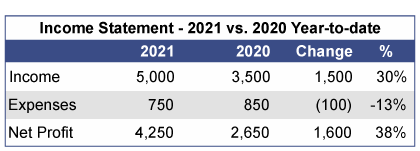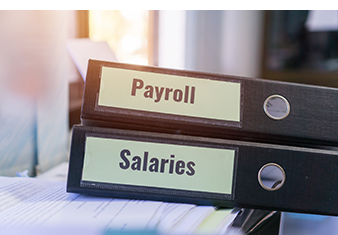 Your business has a story to tell. And one of the ways to hear your business’s story is by reading through comparative financial statements.
Your business has a story to tell. And one of the ways to hear your business’s story is by reading through comparative financial statements.
The importance of comparative financial statements
An up-to-date balance sheet, income statement and statement of cash flows are essential financial reports you should consistently analyze. But these financial statements by themselves don’t tell the whole story about your business. Consider the following:
- Company XYZ: The most current balance sheet shows $1 million in liquid assets with zero liabilities.
- Company ABC: The most current income statement has a net profit margin of 35%.
- Company 123: The statement of cash flows shows that the company has consistently brought in more cash than it has spent over the past three years.
And here’s the rest of the story:
- Company XYZ: Liquid assets decreased from $5 million to $1 million over the past 12 months.
- Company ABC: Net profit margin is typically around 20% for this company. However, a recent round of layoffs temporarily pushed total salaries and wages lower, while pushing the net profit margin much higher.
- Company 123: There has been a steady decline in positive cash flow over the past three years.
These examples show the importance of analyzing your financial statements in comparison with something else. Reading through the first list of bullet points only tells part of the story.
What you can do
Here are several types of comparative financial statements you can create for your business and some tips for getting the most out of these reports.
- Current period vs. Prior period. Compare this month to the same month one year prior (October 2021 vs. October 2020) or compare by year (2021 Year-to-Date vs. 2020 Year-to-Date).
- Current period vs. Current period forecast. This is known as a variance analysis. You compare what you think was going to occur during a particular period to what actually happened. This report can also be done either by month [October 2021 (actual) vs. October 2021 (forecast)] or by year [2021 Year-to-Date (actual) vs. 2021 Year-to-Date (forecast)]
- Use both absolute figure and percentages. Percentages allow you to quickly see the degree of change between the two periods that are being compared. Here’s an example of what this could look like:

- Ask for help! Please contact your financial advisor or accountant if you would like help creating or analyzing comparative financial statements for your business.
Here are some ideas to lower your business taxes, get organized, and to prepare for filing your 2021 tax return.
 As 2021 winds down, here are some ideas to consider in order to help manage your small business and prepare for filing your upcoming tax return.
As 2021 winds down, here are some ideas to consider in order to help manage your small business and prepare for filing your upcoming tax return.
- Identify all vendors who require a 1099-MISC and a 1099-NEC. Obtain tax identification numbers (TIN) for each of these vendors.
- Determine if you qualify for the Paycheck Protection Program (PPP) safe harbor threshold that allows you to deduct certain 2020 expenses on your 2021 tax return.
- Consider accelerating income or deferring earnings, based on profit projections.
- Section 179, or bonus depreciation expensing versus traditional depreciation, is a great planning tool. If using Section 179, the qualified assets must be placed in service prior to year-end.
- Business meals are 100% deductible in 2021 if certain qualifications are met. Retain the necessary receipts and documentation that note when the meal took place, who attended and the business purpose of the meal on each receipt.
- Consider any last-minute deductible charitable giving including long-term capital gain stocks.
- Review your inventory for proper counts and remove obsolete or worthless products. Keep track of the obsolete and worthless amounts for a potential tax deduction.
- Set up separate business bank accounts. Co-mingling business and personal expenses in one account is not recommended.
- Create expense reports. Having expense reports with supporting invoices will help substantiate your tax deductions in the event of an audit.
- Organize your records by major categories of income, expenses and fixed assets purchased to make tax return filing easier.
- Review your receivables. Focus on collection activities and review your uncollectable accounts for possible write-offs.
- Make your 2021 fourth-quarter estimated tax payment by January 18, 2022.
 Meetings, phone calls, emails, text messages, and water cooler conversations with your employees constantly bombard you as a business owner. Freeing up even just another 15 minutes a day could dramatically improve both your workflow and peace of mind.
Meetings, phone calls, emails, text messages, and water cooler conversations with your employees constantly bombard you as a business owner. Freeing up even just another 15 minutes a day could dramatically improve both your workflow and peace of mind.
Here are some suggestions for getting back 15 minutes every day:
- Use your phone. Whenever possible, use your phone instead of an email. Oftentimes talking with someone directly is more efficient than spending the time to compose an email. Plus, email chains can fill your inbox and require precious minutes to read and decipher. Using the phone can also help avoid potential misunderstandings, as a person’s tone of voice conveys information that may be lost or misinterpreted when shared via a written message.
- Be brief with emails. Tech entrepreneurs Mark Cuban and Jeff Bezos are known for their brief emails that consist of only a couple words. In situations where you do use email, consider crafting a response that is only several words in length. And remember the golden rule of emails: send fewer emails to receive fewer emails.
- Plan your meetings. Face-to-face time with colleagues, vendors, and customers is often productive and essential for growing a business. On the other hand, meetings can be a huge waste of time if not properly planned. Establish clear goals for a meeting in advance so your team can focus on priorities and get back to work.
- Minimize distractions. Business owners enjoy developing a rapport with their employees. These personal conversations, however, need to have boundaries so that both you and your employee can stay on task. Tell your team if there’s a day you don’t have time for small talk. Consider putting an old-fashioned Do Not Disturb sign on your door when you need to get things done.
- Delegate when possible. If you’re a small business owner who built a company from scratch, you may be reluctant to relinquish control over day-to-day operations. But failure to delegate can sap time from more important tasks like planning, building relationships with key vendors, and growing your customer base. So, develop a plan to train your employees to assume more responsibility over time.
Fifteen minutes may not seem like much, but a busy business owner can work wonders with just a little more time every day.
As summer winds down, your business’s financial statements may be due for a quick check-up. Here are several review suggestions to help determine the health of your business prior to year-end.
- Balance sheet reconciliations. Reconcile each asset and liability account every quarter. A well-supported balance sheet can guide decisions about cash reserves, debt financing, inventory management, receivables, payables, and property. Regular monitoring can highlight vulnerabilities, providing time for corrective action.
- Debt service coverage. Do you have enough cash to adequately handle principal and interest payments? Calculate your cash flow to ensure you can handle both current and future monthly loan payments.
- Projected revenue. Take a look at your income statements and see how your revenue has performed so far this year versus what you thought your revenue was going to be. If revenue varies from what you expect, get with your sales and marketing team to pinpoint what has gone better, or worse, than expected.
- Projected expenses. Put a stop to disappearing cash by conducting a variance analysis of your expenses. What did you expect to spend so far in 2021 on salaries and wages compared to what you actually paid your employees? What about other big expenses like rent or insurance? Take the amount of money actually spent so far in 2021 in each of your major expense accounts and compare it to your spending forecast. Then create an updated forecast for the balance of the year.
A review of your financial statements now will help you be prepared if you need to navigate an obstacle or capitalize on potential opportunities to expand your business.
Summer’s almost here, and soon most children will be on their long-awaited summer vacation. If you own or manage a business, have you thought of hiring your children, nieces, or nephews for a summer job?
If you do it right, it can be a win-win situation for everyone.
The kids will earn some money and gain valuable real-life experience in the workplace while your business will have some extra help during summer months when other staff may be on vacation. If it’s a family business, there might even be some tax advantages as well.
 If your child is doing a valid job and the pay is reasonable for the work, your business can generally claim a normal tax expense for wages paid. Your child will probably pay no or very little income tax on the wages they earned. And if the child is under age 18 and your business is unincorporated, neither your child nor your business will have to pay Social Security or Medicare payroll taxes in most cases.
If your child is doing a valid job and the pay is reasonable for the work, your business can generally claim a normal tax expense for wages paid. Your child will probably pay no or very little income tax on the wages they earned. And if the child is under age 18 and your business is unincorporated, neither your child nor your business will have to pay Social Security or Medicare payroll taxes in most cases.
To make the arrangement work, follow the following guidelines:
- Ensure it’s a real job. It could be a simple job, such as office filing, packing orders, or simple production activities. But it needs to be an actual job.
- Treat your child like any other employee. Expect your child to work regular hours and exhibit appropriate behavior. Don’t show favoritism or you risk upsetting regular employees.
- Keep proper documentation. Keep records of hours worked just as you would for any employee. If possible, pay your child using your normal payroll system and procedures.
- Avoid family disputes. If the arrangement is not working, or is disrupting the business, help your child find a summer job at another business.
Your firm survived 2020. Now you may be asking yourself when will the economy return to pre-pandemic levels? Will it be this fall? A year from now? Longer?
 Until the economy fully emerges from the pandemic, small businesses can help one another stay afloat. By collaborating with other like-minded firms, your business can find creative ways to strengthen local markets and encourage consumer loyalty.
Until the economy fully emerges from the pandemic, small businesses can help one another stay afloat. By collaborating with other like-minded firms, your business can find creative ways to strengthen local markets and encourage consumer loyalty.
Consider the following ideas of how you can help each other:
- Partner with industry peers. One Vietnamese restauranteur in New York City was eager to open his business for in-person dining. Then the pandemic hit. According to a Time Magazine article, two years of careful planning, hard work and sacrifice seemed fruitless. But sympathetic restaurant owners in nearby Chinatown reached out with an innovative idea: offer a punch card to encourage customers to support local businesses. By partnering with this newly-minted entrepreneur and introducing him to like-minded people, established firms kept the restaurant business alive in their locale and helped a fledgling owner pursue his dream.
- Donate staff resources. During government-mandated quarantines, some industries enjoyed burgeoning revenues while others were trying to keep staff employed. Why not offer to help if you have excess labor? For example, businesses selling camping gear and recreational vehicles saw an uptick in consumer demand. A company supporting that industry might offer some of its staff on a temporary basis to help another firm meet customer needs. Such a partnership could provide the added benefit of boosting morale and avoiding layoffs.
- Leverage locations. Say you’re a company that raises chickens. You might partner with a firm offering other meat products to share a tent at a farmer’s market. Or two dance studios might join forces to enable patrons to attend similar classes at across-town venues. You could team up with others to organize a business fair. Or you might donate space to help another business sell goods at a common location for centralized pickup and delivery.
- Share your expertise. Perhaps you’ve experienced great success with your business website, but other firms are struggling to make inroads in the digital marketplace. You could teach these companies how to connect with customers via social media. Train them to build and market a website. If you have remote workers, share your experience about helping home-based employees stay productive.
- Cross promotions. Look for businesses that you can help and that can help you. Then cross-promote each other’s services. Customers of dog groomers need veterinarians and vice versa. Accountants need their hair cut and customers of hair salons need accountants. Vacation rental property owners can offer restaurant deals for their renters and restaurants can offer the rental owners coupons for meals. The ideas are endless, you just need to think creatively.
Before making a commitment to help another business, be sure to weigh the pros and cons. Any potential relationship should benefit both parties. Don’t be afraid to consider companies outside your industry or local market, but look first to businesses with services and products complementing your own.
Here are some suggestions to help you master the art of documenting and organizing your business now and in the future.
- Document policies and procedures. Write down daily responsibilities, skills needed to complete tasks related to these responsibilities, and the location of all paper and electronic files. Appoint and cross-train backup staff to ensure these daily tasks are done.
- Document your succession plan. It may not be for another 10 or 20 years, but documenting your succession plan is critical for both you as the owner and for your employees. Consider how much longer you plan on owning the business and who you have in mind to take over after you leave. If you currently don’t have a successor in mind, document your plan to either train or find this person(s).
- Document your tax planning strategy. Be aware of possible tax incentives, such as credits for hiring certain workers and accelerated depreciation available for acquiring business assets. For example, for asset purchases, retain receipts and record the purchase details. These details include the type of equipment, the acquisition date, the amount of the purchase, the date you began using the equipment, and a schedule of related set-up costs.
- Organize your daily documents. Organize your desk by shredding documents with sensitive information and scanning older papers into computer files. The most efficient method is to scan, file, and shred as soon as you are finished with a document. If you don’t have time, consider assigning document organization to specific employees and making it a task to be completed on a daily basis.
 You’re busy, and you may feel that organizing your records will take more time than you have available. But spend a minute and consider how using these organizational tips may save you not only time, but money as well.
You’re busy, and you may feel that organizing your records will take more time than you have available. But spend a minute and consider how using these organizational tips may save you not only time, but money as well.
If you or your business received funds from the Paycheck Protection Program (PPP), the recently passed Emergency Coronavirus Relief Act of 2020 will help to dramatically cut your tax bill. Here’s what you need to know.
Background
 The PPP program was created by the CARES Act in March 2020 to help businesses which were adversely affected by the COVID-19 pandemic. Qualified businesses could apply for and receive loans of up to $10 million. Loan proceeds could be used to pay for certain expenses incurred by a business, including salaries and wages, other employee benefits, rent and utilities.
The PPP program was created by the CARES Act in March 2020 to help businesses which were adversely affected by the COVID-19 pandemic. Qualified businesses could apply for and receive loans of up to $10 million. Loan proceeds could be used to pay for certain expenses incurred by a business, including salaries and wages, other employee benefits, rent and utilities.
If the business used at least 60% of loan proceeds towards payroll expenses, the entire amount of the loan would be forgiven.
The Dilemma
While the CARES Act spelled out that a business’s forgiven PPP loan would not be considered taxable income, the legislation was silent about how to treat expenses paid for using PPP loan proceeds if the loan was ultimately forgiven.
Congress intended for these expenses to be deductible for federal tax purposes. But since the legislation was silent on this issue, the IRS swooped in and deemed these expenses to be nondeductible.
There was considerable debate over the latter half of 2020, with Congressional politicians explaining that their intent was that the expenses be deductible and the IRS responding “Too bad, they’re nondeductible.”
The Solution
Congress overruled the IRS’s position in the Emergency Coronavirus Relief Act of 2020. The legislation officially makes deductible for federal tax purposes all expenses paid for using proceeds from a forgiven PPP loan.
Stay tuned for updates as to how this new legislation affects your business.
If you are working from home for the first time in 2020, you may be wondering if your home office is tax deductible. The bad news? If you’re working from home for an employer, you normally can’t deduct your home office expenses.
 Here’s a quick look at the basic requirements to be able to deduct your home office expenses, along with some suggestions for how to qualify for the deduction if you’re currently working for your company as an employee.
Here’s a quick look at the basic requirements to be able to deduct your home office expenses, along with some suggestions for how to qualify for the deduction if you’re currently working for your company as an employee.
The basics
There are two requirements for having a tax-deductible home office:
- Your home office is only used for business purposes. Your home office must be used exclusively for operating your business. It can’t double as the family media center or living room. To meet this requirement, set up your office in a separate area of your house. Then if you get audited by the IRS, there is no doubt that your office is used exclusively for business purposes.
- Your home office is your primary place of business. You need to demonstrate that your home office is the primary place you conduct your business. The IRS has clarified that you can meet clients and conduct meetings at separate office locations, but your home office must be the only location where your administrative work is completed. So, if you meet with clients or work on any part of your business away from your home office, keep a journal of each specific activity undertaken and describe how it doesn’t violate the primary place-of-business rule.
Looking at these two criteria, everyone that is now required to work from home probably meets both qualifications. If you’re a W-2 employee, however, you can’t deduct your home office expenses on your tax return.
Solving the problem
Here are three options for solving your problem of being a W-2 employee and qualifying to deduct your home office expenses on your tax return.
- Become an independent contractor. The easiest way to deduct your home office expenses is by switching from being an employee to an independent contractor. With a number of firms cutting pay and hours due to the pandemic, it may be worth exploring. There’s a big warning label if you go this route, however. You will need to account for lost benefits, such as health insurance, and the additional cost of self-employment taxes. If you can meet the IRS requirements for becoming an independent contractor, it may be worth doing the math and considering all the deductions your home office may make available to you.
- Start a side business. If becoming an independent contractor for your current employer isn’t an option, consider starting a side business. You can deduct all business-related expenses on your tax return, including your home office expenses. If you go this route, ensure your home office is in a different location in your home than your other work space.
- Consider your entire household. Even if you don’t qualify for the home office deduction, maybe someone else living in your home does qualify. So, look into your options to see if a family member can take advantage of the home office deduction.
What if none of these options for deducting home office expenses are feasible for you? While you won’t be able to deduct your home office expenses on your tax return, you may still be able to end up financially ahead with the help of your employer.
Get reimbursed by your company
There’s no question you are picking up some of the expense of your home office with added electrical, heating, telephone, internet, and other expenses. One way companies are solving this is by allowing employees to submit valid expense reports to cover some of these extra costs. They do this by setting up an accountable plan. With financial pressures on businesses, this might be a tough subject to broach, but if the system is already in place you may be able to find a way to get some of your home office expense reimbursed.
So if you’re stuck working as a W-2 employee, look into whether your employer offers reimbursement for home office expenses.
Figuring out how to properly deduct your home office or get reimbursed by your employer can be a lot more complicated than it appears. If you need help, contact your financial advisor.
Your company’s online presence leaves a lasting impression—positive or negative. When people check out your homepage, will they stick around? Will they buy? Will they return? Make your website easy to use and current, and new orders may be just a click away. Annoy visitors and they’ll flee to a competitor.
Steer clear of the following website mistakes:
Designing the website for you—not the customer. Studies have shown that online visitors form an opinion of a company’s brand in about three seconds. If your home page is well designed, they may stick around for another ten to twenty seconds. Don’t waste these precious moments spouting details about the firm’s stellar history and the owner’s credentials. Consumers are visiting your website to get answers. Provide these answers quickly or they’ll click elsewhere.
 Heavy graphics, poor load time. Many consumers are surfing the web from smart phones and tablets. Don’t make them waste valuable time waiting for a fancy webpage to load. Consider projecting a professional image with text-based content that answers the most pressing questions about your products and services. Graphics can work well, but only if size and load times are fully vetted to ensure a seamless load experience.
Heavy graphics, poor load time. Many consumers are surfing the web from smart phones and tablets. Don’t make them waste valuable time waiting for a fancy webpage to load. Consider projecting a professional image with text-based content that answers the most pressing questions about your products and services. Graphics can work well, but only if size and load times are fully vetted to ensure a seamless load experience.
Unfriendly navigation. If your homepage looks cluttered, potential customers will become frustrated. Make it easy for users to navigate your site from home page to supplemental pages and back again. Use a handful of clearly-labeled tabs in a top-level menu. Deliberately design each page to have the same look and feel.
Stale data. When you visit a webpage and note that it was last updated five years ago, do you sense a vibrant, cutting-edge enterprise? Keep your site up to date. Consider subscribing to content services that will keep your information fresh. Remember, developing a web presence is not an event, it is an ongoing journey. Your site must display current prices, merchandise that’s available right now, with up-to-date details about new product offerings.
Sloppy content. A website riddled with typos, grammatical mistakes and industry jargon will turn customers away. Visitors may ask themselves if your business doesn’t care about the quality of its website, how can they trust your products and services?
A carefully crafted website can draw customers in, enhance their buying experience and leave a lasting impression of professionalism and quality.